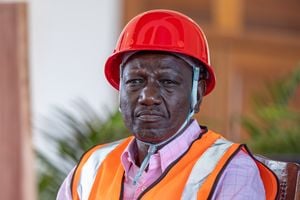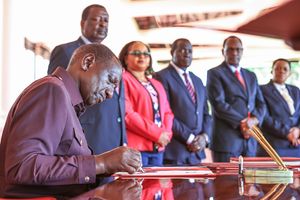
Kenya Mortgage Refinance Company has set up a scheme that will provide a partial guarantee for any mortgage extended to 'hustlers'
The Kenya Mortgage Refinance Company (KMRC) has created a trust that will run a guarantee scheme aimed at cushioning banks and saccos extending home loans to low-income workers, including those in informal sector.
KMRC chief executive officer Johnstone Oltetia said a company known as Kenya Mortgage Guarantee Trust (KMGT) has already been formed to manage the scheme that would provide a partial guarantee for any mortgage extended to persons deemed to be high-risk and is aimed at expanding access to housing by boosting the confidence of lenders.
“KMRC has already registered the Kenya Mortgage Guarantee Trust (KMGT), a separate legal entity from KMRC to operationalise the risk-sharing arrangement,” Mr Oltetia said via email.
“We have hired international consultants to help prepare the operational frameworks, including the rules and financial models.”
A mortgage guarantee is a commitment that in the event of a default, the guarantor (in this case KMGT) will pay the mortgage lender for any loss as a result of a property foreclosure, up to a specific amount.
This means that participating lenders would be provided with a cushion from the kitty set up by KMRC should borrowers classified as high-risk default on their mortgage obligations.
This intervention is expected to catalyse the appetite for banks and saccos to disburse mortgages within pockets of the economy widely deemed to be of high risk.
Kenya has a thin retail mortgage market, estimated at 27,786 home loans worth Sh261.8 billion in December 2022, according to the latest data from the Central Bank of Kenya.
The average home loan size advanced by commercial banks was in 2022 estimated at Sh9.4 million, increased from Sh9.2 million a year earlier. That has locked out low- to mid-income workers because of the high repayment costs which cannot be supported by their payslips.
The high cost of home loans for workers is what prompted the previous administration of President Uhuru Kenyatta to partner with private lenders and development financiers to form KMRC to derisk the mortgage market.
KMRC seeks to achieve this by offering long-term funds to participating banks and saccos at a fixed interest rate of five percent for onward lending to prospective homeowners earning a maximum monthly pay of Sh200,000.
The recipient primary lenders are, in turn, expected to advance the cash to qualifying homebuyers at a single-digit interest rate — meaning the repayments are not impacted by inflation and other macroeconomic fundamentals.
The credit-sharing facility is expected to expand KMRC’s product offering to workers in the informal or the Jua Kali sector, who account for about 84 percent of Kenya’s total labour force.
“We shall be conducting industry sensitisation workshops in due course on the operational framework,” Mr Oltetia said. “So far the reception is good and the stakeholders look forward to the operationalisation of KMGT.”
President William Ruto has made the construction of affordable houses a priority in his first term in office, pledging to put up 250,000 units every year, funded by a 1.5 percent tax on workers’ monthly pay and matched by employers.
Deductions of the housing levy — a gross-on-gross taxation on workers' income where the Kenya Revenue Authority uses the same gross to also calculate the Pay As You Earn, thus a form of double taxation— resumes this month after a two-month hiatus.
The levy had been suspended for January and February after it was rendered unconstitutional by the courts before being resuscitated by lawmakers through a new Act.
The lowest-priced unit (a single room on a 20 square-metre space) will cost Sh840,000 with prospective buyers required to deposit Sh84,000 before occupation and clear the remainder through monthly payments of Sh3,200 in 30 years.
A two-room house sitting on 30 square-metre will cost Sh1.26 million, with prospective owners required to deposit Sh126,000 and thereafter pay Sh4,800 monthly for 30 years, while the price for a 40sqm three-room unit is Sh1.68 million paid through Sh168,000 deposit and Sh6,400 monthly payments.
A bedsitter, or studio, on a 20 square-metre space, will cost Sh960,000, with occupiers charged Sh5,200 monthly payments for 30 years on top of a Sh96,000 deposit.










